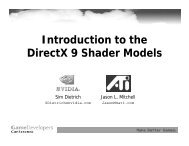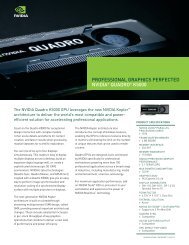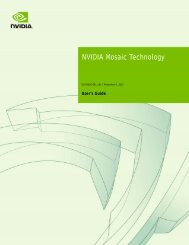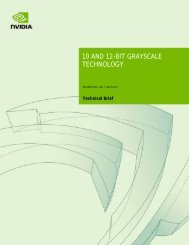Segmented Scan - Nvidia
Segmented Scan - Nvidia
Segmented Scan - Nvidia
Create successful ePaper yourself
Turn your PDF publications into a flip-book with our unique Google optimized e-Paper software.
State of the Art in GPU<br />
Data-Parallel Algorithm Primitives<br />
Mark Harris<br />
NVIDIA
Stream Programming Model<br />
• Many independent threads of execution<br />
— All running the same program<br />
• Threads operate in parallel on separate inputs<br />
— Produce an output per input<br />
• Works well when outputs depend on small, bounded input
Stream Parallelism<br />
Input<br />
Thread Thread Thread Thread<br />
Output<br />
• One-to-one Input-output dependence (e.g., scalar)
Stream Parallelism<br />
Input<br />
Thread Thread Thread Thread<br />
Output<br />
• Local neighborhood input-output dependence (e.g., stencil)
Beyond streaming<br />
• GPUs are obviously really good at local and 1:1 dependences<br />
— But many applications have more complex dependencies<br />
— … and variable output<br />
• Global, dynamic input-output dependences are common<br />
— Sorting, building data structures
GPU<br />
Territory!<br />
• Use efficient<br />
algorithm<br />
primitives for<br />
common patterns
Parallel Patterns<br />
• Many parallel threads need to generate a single result value<br />
— ―Reduce‖<br />
• Many parallel threads need to partition data<br />
— ―Split‖<br />
• Many parallel threads, variable output per thread<br />
— ―Compact‖ / ―Allocate‖
Reduce<br />
Input<br />
3.4 4.1 2.0 1.5 9.6 0.3 7.1 1.4<br />
+<br />
Output 29.4<br />
• Global data dependence?
Parallel Reduction: Easy<br />
3 1 7 0 4 1 6 3<br />
4 7 5 9<br />
11 14<br />
+ + + +<br />
25<br />
• Repeated local neighborhood access: O(log n) reps<br />
— Static data dependences, uniform output
Parallel Patterns<br />
• Many parallel threads need to generate a single result value<br />
— ―Reduce‖<br />
• Many parallel threads need to partition data<br />
— ―Split‖<br />
• Many parallel threads, variable output per thread<br />
— ―Compact‖ / ―Allocate‖
Split<br />
Input<br />
Output<br />
• Example: radix sort, building trees
Parallel Patterns<br />
• Many parallel threads need to generate a single result value<br />
— ―Reduce‖<br />
• Many parallel threads need to partition data<br />
— ―Split‖<br />
• Many parallel threads, variable output per thread<br />
— ―Compact‖ / ―Allocate‖
Compact<br />
• Remove unneeded or invalid elements (blue)<br />
Input<br />
Output<br />
• Example: collision detection
Variable Output Per Thread: General Case<br />
• Allocate Variable Storage Per Thread<br />
2 1 0 3 2<br />
Input<br />
A<br />
C<br />
D<br />
G<br />
B<br />
E<br />
H<br />
F<br />
Output<br />
A B C D E F G H<br />
• Example: marching cubes
“Where do I write my output?”<br />
• Split, compact and allocate require all threads to answer<br />
• The answer is:<br />
―That depends on how much the other threads output!‖<br />
• ―<strong>Scan</strong>‖ is an efficient, parallel way to answer this question
Parallel Prefix Sums (<strong>Scan</strong>)<br />
• Given array A = [a 0 , a 1 , …, a n-1 ]<br />
and a binary associative operator with identity I,<br />
scan(A) = [I, a 0 , (a 0 a 1 ), …, (a 0 a 1 … a n-2 )]<br />
• Example: if<br />
is +, then<br />
<strong>Scan</strong>([3 1 7 0 4 1 6 3]) = [0 3 4 11 11 15 16 22] (exclusive)<br />
<strong>Scan</strong>([3 1 7 0 4 1 6 3]) = [3 4 11 11 15 16 22 25] (inclusive)
<strong>Segmented</strong> <strong>Scan</strong><br />
Segment Head Flags<br />
Input Data Array<br />
<strong>Segmented</strong> scan<br />
[ 0 0 1 0 0 1 0 0 ]<br />
[ 3 1 7 0 4 1 6 3 ]<br />
[ 0 3 0 7 7 0 1 7 ]<br />
• <strong>Segmented</strong> scan provides nested parallelism<br />
— Arrays can be dynamically subdivided and processed in parallel<br />
• Enables algorithms such as parallel quicksort, sparse matrixvector<br />
multiply, etc.<br />
S. Sengupta, M. Harris, Y. Zhang, and J.D. Owens.<br />
―<strong>Scan</strong> Primitives for GPU Computing‖. Graphics Hardware 2007
How fast?<br />
• Bandwidth bound primitives<br />
— 1 add per element read/write<br />
— <strong>Scan</strong> and reduce at memory saturated rates<br />
• Geforce GTX 280<br />
— <strong>Scan</strong> 11.8B elements/second (32-bit elements)<br />
— Bandwidth: <strong>Scan</strong> 138 GB/s; Reduce 152 GB/s<br />
D. Merrill & A. Grimshaw ―Parallel <strong>Scan</strong> for Stream Architectures‖. Tech. Report CS2009-<br />
14, Department of Computer Science, University of Virginia.
<strong>Scan</strong> Applications
Applications of <strong>Scan</strong><br />
• A simple and useful building block for many parallel apps:<br />
Compaction<br />
Radix sort<br />
Quicksort (segmented scan)<br />
String comparison<br />
Lexical analysis<br />
Stream compaction<br />
Run-length encoding<br />
Allocation<br />
Polynomial evaluation<br />
Solving recurrences<br />
Tree operations<br />
Histograms<br />
Summed area tables<br />
And many more!<br />
• (Interestingly, scan is unnecessary in sequential computing)
Compact using <strong>Scan</strong><br />
• Flag unneeded elements with zero:<br />
Input<br />
0 1 0 1 0 1 1 1 0<br />
1 1 0<br />
<strong>Scan</strong> 0 0 1 1 2 2 3 4 5 5 6 7<br />
• Threads with flag == 1 use scan result as address for output:<br />
Output<br />
0 1 2 3 4 5 6<br />
Recent efficient approach:<br />
M. Billeter, O. Olson, U. Assarson. “Efficient stream compaction on wide<br />
SIMD many-core architectures”. HPG 2009.
Radix Sort / Split using <strong>Scan</strong><br />
i = index<br />
0 1 2 3 4 5 6 7<br />
b = current bit 010 2 001 1 111 7 011 3 101 5 011 3 0000 110 6<br />
Current Digit: 0<br />
d = invert b 1 0 0 0 0 0 1 1<br />
f = scan(d) 0 1 1 1 1 1 1 2<br />
numZeros=3<br />
t = numZeros + i – f 3 3 4 5 6 7 8 8<br />
out = b ? t : f 0 3 4 5 6 7 1 2<br />
010 000 110 001 111 011 101 011
Radix Sort / Split using <strong>Scan</strong><br />
i = index<br />
b = current bit<br />
0 1 2 3 4 5 6 7<br />
2 1 7 3 5 3 0 6<br />
010 000 110 001 111 011 101 011<br />
Current Digit: 1<br />
d = invert b 0 1 0 1 0 0 1 0<br />
f = scan(d) 0 0 1 1 2 2 2 3<br />
numZeros=3<br />
t = numZeros + i – f 3 4 4 5 5 6 7 7<br />
d = b ? t : f 3 0 4 1 5 6 2 7<br />
000 001 101 010 110 111 011 011
Radix Sort / Split using <strong>Scan</strong><br />
i = index<br />
b = current bit<br />
0 1 2 3 4 5 6 7<br />
000 001 101 010 110 111 011 011<br />
Current Digit: 2<br />
d = invert b 1 1 0 1 0 0 1 1<br />
f = scan(d) 0 1 2 2 3 3 3 4<br />
numZeros=5<br />
t = numZeros + i – f 5 5 5 6 6 7 8 8<br />
d = b ? t : f 0 1 5 2 6 7 3 4<br />
0 1 2 3 3 5 6 7<br />
000 001 010 011 011 101 110 111
CUDA Radix Sort<br />
• Sort blocks in shared mem<br />
— 4-bit radix digits, so 4<br />
split operations per digit<br />
• Compute offsets for each<br />
block using prefix sum<br />
• Scatter results to offset<br />
location<br />
N. Satish, M. Harris, M. Garland.<br />
“Designing Efficient Sorting Algorithms<br />
for Manycore GPUs”. IPDPS 2009
Faster Radix Sort Via Rigorous Analysis<br />
• Meta-strategy leads to ultra-efficient bandwidth use and<br />
computation<br />
— Optimized data access saturates bandwidth<br />
— Combine multiple related compact ops into a single scan<br />
— Reduce-then-scan strategy<br />
• Radix sort 1B keys/s on Fermi! (Up to 3.8x vs. Satish et al.)<br />
• See Duane Merrill’s GTC talk<br />
―Optimization for Ninjas: A Case Study in High-Performance Sorting”<br />
D. Merrill and A. Grimshaw, "Revisiting Sorting for GPGPU Stream Architectures,"<br />
University of Virginia CS Tech. Report CS2010-03<br />
Open Source: http://code.google.com/p/back40computing
Designing Sorting Algorithms for GPUs<br />
• Algorithms should expose regular fine-grained parallelism<br />
— scan used to regularize<br />
— In merging, use divide-and-conquer to increase parallelism close to<br />
tree root (Satish et al. 2007)<br />
— Optimize memory access granularity first – max bandwidth is key<br />
• Comparison vs. Key-manipulation<br />
— Comparison sort = O(n log n), works for any criterion<br />
— Radix sort = O(n), but requires numeric key manipulation<br />
• Important to handle key-value pairs<br />
— Pointer-as-value enables sorting big objects
Comparison Sorting Algorithms<br />
• Use comparison sorting when key manipulation not possible<br />
— Variations on parallel divide-and-conquer approach<br />
• Sample Sort (Fastest current comparison-based sort)<br />
— Leischner, Osipov, Sanders. IPDPS 2010<br />
• Merge Sort<br />
— Satish, Harris, Garland. IPDPS 2009<br />
• Parallel Quicksort<br />
— Cederman & Tsigas, Chalmers U. of Tech. TR#2008-01<br />
— Sengupta, Harris, Zhang, Owens, Graphics Hardware 2007
Building Trees<br />
• The split primitive can be applied to any Boolean criterion…<br />
• Hierarchies built by splitting on successive spatial partitions<br />
— E.g. splitting planes<br />
• Trees: special case of sorting!
Bounding Volume Hierarchies<br />
• Bounding Volume Hierarchies:<br />
— Breadth-first search order construction<br />
— Use space-filling ―Morton curve‖ to reduce<br />
BVH construction to sorting<br />
— Requires 2 O(n) radix sorts<br />
C. Lauterbach, M. Garland, S. Sengupta, D. Luebke,<br />
D. Manocha. ―Fast BVH Construction on GPUs‖.<br />
Eurographics 2009<br />
“LBVH” – Linear Bounding Volume Hierarchies
HLBVH<br />
• Improvement over LBVH<br />
— 2-3x lower computation, 10-20x lower bandwidth<br />
— 2-4x more compact tree memory layout<br />
• J. Pantaleoni, D. Luebke. "HLBVH: Hierarchical LBVH Construction for Real-<br />
Time Ray Tracing‖, High Performance Graphics 2010.
k-d Trees<br />
• Spatial partition for organizing points in k-dimensional space<br />
— Commonly used in ray tracing, photon mapping, particle simulation<br />
• Breadth-first search order<br />
— Parallelizes on nodes at lower tree levels (many nodes)<br />
— Parallelizes on geometric primitives at upper tree levels (few nodes)<br />
K. Zhou, Q. Hou, R. Wang, B. Guo.<br />
―Real-Time KD-Tree Construction on<br />
Graphics Hardware‖. SIGGRAPH Asia 2008
Breadth-First Search Order<br />
• BFS order construction maximizes parallelism<br />
• Breadth First:<br />
• Depth First:
Memory-Scalable Hierarchies<br />
• Breadth-first search order has high storage cost<br />
— Must maintain and process lots of data simultaneously<br />
• Solution: partial breadth-first<br />
search order<br />
— Limit number of parallel splits<br />
— Allows scalable, out-of-core<br />
construction<br />
— Works for kD-trees and BVH<br />
Q. Hou, X. Sun, K. Zhou, C. Lauterbach, D. Manocha.<br />
“Memory-Scalable GPU Spatial Hierarchy Construction” IEEE TVCG, 2010.
Parallel Hashing<br />
• Dense data structure for storing sparse items<br />
— With fast construction and fast random access<br />
• Hybrid multi-level, multiple-choice (―cuckoo‖) hash algorithm<br />
— Divide into blocks, cuckoo hash within each block in shared memory<br />
• D. A. Alcantara, A. Sharf, F. Abbasinejad, S. Sengupta, M. Mitzenmacher, J. D. Owens, N. Amenta.<br />
―Real-Time Parallel Hashing on the GPU‖. SIGGRAPH Asia 2009 (ACM TOG 28(5)).
Cuckoo Hashing<br />
• Sequential insertion:<br />
A B C D E<br />
1. Try empty slots first<br />
2. Evict if none available<br />
h1(k)<br />
h2(k)<br />
3. Evicted key checks its other<br />
locations<br />
4. Recursively evict<br />
• Assume impossible after O(lg n)<br />
iterations<br />
— Rebuild using new hash functions<br />
A<br />
BC<br />
D<br />
D<br />
B<br />
A<br />
C<br />
Pagh and Rodler [2001]
Cuckoo Hashing<br />
• Sequential insertion:<br />
A B C D E<br />
1. Try empty slots first<br />
2. Evict if none available<br />
h1(k)<br />
h2(k)<br />
3. Evicted key checks its other<br />
locations<br />
E<br />
A<br />
4. Recursively evict<br />
D<br />
E<br />
• Assume impossible after O(lg n)<br />
iterations<br />
— Rebuild using new hash functions<br />
D<br />
B<br />
C<br />
B<br />
Pagh and Rodler [2001]
Cuckoo Hashing<br />
• Sequential insertion:<br />
1. Try empty slots first<br />
2. Evict if none available<br />
3. Evicted key checks its other<br />
locations<br />
4. Recursively evict<br />
• Assume impossible after O(lg n)<br />
iterations<br />
— Rebuild using new hash functions<br />
h 1 (k)*<br />
A<br />
D<br />
A B C D<br />
E<br />
h 2 (k)*<br />
B<br />
C<br />
Pagh and Rodler [2001]
GPU Parallel Hash Performance<br />
D. A. Alcantara, A. Sharf, F. Abbasinejad, S. Sengupta, M. Mitzenmacher, J. D. Owens, N. Amenta.<br />
“Real-Time Parallel Hashing on the GPU”. SIGGRAPH Asia 2009 (ACM TOG 28(5)).
List Ranking<br />
• Traverse a linked list and assign rank to each node<br />
— Rank = order in list<br />
• Difficult for random lists due to irregular memory access<br />
— Pointer chasing<br />
• Recursive list subdivision<br />
— Helman-JáJá algorithm<br />
M. S. Rehman, K. Kothapalli, P. J. Narayanan.<br />
―Fast and Scalable List Ranking on the GPU‖. ICS 2009.
Implementing <strong>Scan</strong>: Strategies
<strong>Scan</strong> is recursive<br />
• Build large scans from small ones<br />
— In CUDA, build array scans from thread block scans<br />
— Build thread block scans from warp scans<br />
• One approach: ―<strong>Scan</strong>-<strong>Scan</strong>-Add‖<br />
— Harris et al. 2007, Sengupta et al. 2007, Sengupta et al. 2008/2011)
1. <strong>Scan</strong> All Sub-blocks<br />
3 3<br />
3 3<br />
3 5 8 10 12<br />
2. <strong>Scan</strong> Block Sums<br />
+ + + + + +<br />
3. Add Block Offsets<br />
3 3 3 4 5 6 7 7 8 8 9 10 10 11 11 11 12 13 13 13
Improvement: Reduce-then-<strong>Scan</strong><br />
• <strong>Scan</strong>-<strong>Scan</strong>-Add requires 2 reads/writes of every element<br />
• Instead, compute block sums first, use as prefix for block scans<br />
• 25% lower bandwidth<br />
• Dotsenko et al. 2008,<br />
Billeter et al. 2009,<br />
Merrill & Grimshaw 2009
+ + + + + +<br />
1. Reduce All Sub-Blocks<br />
3 3<br />
3 5 8 10 12<br />
2. <strong>Scan</strong> Block Sums<br />
3 3 3 4 5 6 7 7 8 8 9 10 10 11 11 11 12 13 13 13<br />
3. <strong>Scan</strong> Blocks, using block sums as prefixes
Limit recursive steps<br />
• Can use these techniques to build scans of arbitrary length<br />
— In CUDA, each recursive level is another kernel call<br />
• Better: iterative scans of consecutive chunks<br />
— Each thread block scans many chunks<br />
— Prefix each chunk with sum from of all previous chunks<br />
• Limiting to 2-level scan in this way is much more efficient<br />
— Merrill and Grimshaw, 2009
Implementing <strong>Scan</strong> In CUDA
<strong>Scan</strong> Implementation in CUDA<br />
• In the following examples:<br />
— all pointers assumed to point to CUDA __shared__ memory<br />
— The following variable definitions are assumed (for brevity):<br />
int i = threadIdx.x;<br />
int lane = I & (warpSize - 1);<br />
int warp = i / warpSize ;<br />
int n = blockDim.x;
Sequential Inclusive <strong>Scan</strong> Code<br />
int scan(int *p, int n) {<br />
for (int i=1; i
Simple Parallel Inclusive <strong>Scan</strong> Code<br />
__device__ int scan(int *p) {<br />
for (int offset=1; offset=offset) t = p[i-offset];<br />
__syncthreads();<br />
if(i>=offset) p[i]= t + p[i];<br />
__syncthreads();<br />
}<br />
}
Warp Speed<br />
• Warp is physical unit of CUDA parallelism<br />
— 32 threads that execute instructions synchronously<br />
• Synchronicity of warps can be leveraged for performance<br />
— When sharing data within a warp, don’t need __syncthreads()<br />
• ―Warp-Synchronous Programming‖<br />
— (Powerful, but take care to avoid race conditions!)<br />
Sengupta, Harris, Garland, Owens. Efficient parallel scan algorithms for many-core GPUs.<br />
Scientic Computing with Multicore and Accelerators, chapter 19. 2011 (to appear)
Intra-warp Exclusive <strong>Scan</strong> Code<br />
__device__ int scan_warp(volatile int *p) {<br />
if (lane>= 1) p[i]= p[i- 1] + p[i];<br />
if (lane>= 2) p[i]= p[i- 2] + p[i];<br />
if (lane>= 4) p[i]= p[i- 4] + p[i];<br />
if (lane>= 8) p[i]= p[i- 8] + p[i];<br />
if (lane>=16) p[i]= p[i-16] + p[i];<br />
return (lane>0) ? p[i-1] : 0;<br />
}
Intra-block <strong>Scan</strong> using Intra-warp <strong>Scan</strong><br />
__device__ int block_scan(int* p) {<br />
int prefix = scan_warp(p);<br />
__syncthreads();<br />
if (lane == warpSize - 1) p[warp] = prefix + x;<br />
__syncthreads();<br />
if (warp == 0) p[i] = scan_warp(p);<br />
__syncthreads();<br />
return prefix + p[warp];<br />
}
Binary <strong>Scan</strong><br />
• Often need to scan 1-bit values<br />
— Stream compact: scan true/false flags<br />
— Split / Radix Sort: scan 1-bit flags<br />
• Fermi GPU architecture provides efficient 1-bit warp scan<br />
— int __ballot(int p): 32-bit ―ballot‖ of t/f p from whole warp<br />
— int __popc(int x): count number of 1 bits in x<br />
• Combine with a per-thread mask to get 1-bit warp scan<br />
— Or with no mask for 1-bit warp count
Binary Warp <strong>Scan</strong> Code<br />
__device__ unsigned int lanemask_lt () {<br />
int lane = threadIdx.x & (warpSize-1);<br />
return (1
Block Binary <strong>Scan</strong> Performance<br />
• Substitute binary warp-scan in block_scan<br />
Harris and Garland. ―Optimizing parallel prefix operations for the Fermi<br />
Architecture‖. GPU Computing Gems, vol 2. (to appear)
Binary Reduction<br />
• Count the number of true predicates for all threads in block<br />
— int __syncthreads_count(int p);<br />
— Also __syncthreads_and() and __syncthreads_or()<br />
• Works like __syncthreads(), but counts non-zero p<br />
• 2x faster than<br />
32-bit reduction
Parallel Primitive Libraries
No need to re-implement<br />
• Open source libraries under active development<br />
• CUDPP: CUDA Data-Parallel Primitives library<br />
— http://code.google.com/p/cudpp (BSD License)<br />
• Thrust<br />
— http://code.google.com/p/thrust (Apache License)
CUDPP<br />
• C library of high-performance parallel primitives for CUDA<br />
— M. Harris (NVIDIA), J. Owens (UCD), S. Sengupta (UCD), A. Davidson<br />
(UCD), S. Tzeng (UCD), Y. Zhang (UCD)<br />
• Algorithms<br />
— cudpp<strong>Scan</strong>, cudpp<strong>Segmented</strong><strong>Scan</strong>, cudppReduce<br />
— cudppSort, cudppRand, cudppSparseMatrixVectorMultiply<br />
• Additional algorithms in progress<br />
— Graphs, more sorting, trees, hashing, autotuning
CUDPP Example<br />
CUDPPConfiguration config = { CUDPP_SCAN,<br />
CUDPP_ADD, CUDPP_FLOAT, CUDPP_OPTION_FORWARD };<br />
CUDPPHandle plan;<br />
CUDPPResult result = cudppPlan(&plan,<br />
config,<br />
numElements,<br />
1, 0);<br />
cudpp<strong>Scan</strong>(plan, d_odata, d_idata, numElements);
Thrust<br />
• C++ template library for CUDA<br />
— Mimics Standard Template Library (STL)<br />
• Containers<br />
— thrust::host_vector<br />
— thrust::device_vector<br />
• Algorithms<br />
— thrust::sort()<br />
— thrust::reduce()<br />
— thrust::inclusive_scan()<br />
— Etc. 63
Thrust Example<br />
// generate 16M random numbers on the host<br />
thrust::host_vector h_vec(1
Conclusion: so much to be done!
“In general, the problem of defining parallel-friendly data<br />
structures that can be efficiently created, updated, and<br />
accessed is a significant research challenge… The toolbox of<br />
efficient data structures and their associated algorithms on<br />
scalar architectures like the CPU remains significantly<br />
larger than on parallel architectures like the GPU.”<br />
-- Alcantara et al. “Real-Time Parallel Hashing on the GPU”
See These Talks!<br />
• Duane Merrill:<br />
— Optimization for Ninjas: A Case Study in High-Performance Sorting<br />
— Wednesday, 3pm (Room D)<br />
• Nathan Bell:<br />
— High-Productivity CUDA Development with the Thrust Template<br />
Library<br />
— Thursday, 11am (Marriott Ballroom)<br />
• Jared Hoberock:<br />
— Thrust by Example: Advanced Features and Techniques<br />
— Thursday, 2pm (Room B)
Thank You!<br />
• Duane Merrill, David Luebke, John Owens, CUDPP-dev team,<br />
Nathan Bell, Jared Hoberock, Michael Garland<br />
• Questions/Feedback: mharris@nvidia.com
<strong>Scan</strong> Literature (1)<br />
Pre-GPU<br />
• First proposed in APL by Iverson (1962)<br />
• Used as a data parallel primitive in the Connection Machine (1990)<br />
— Feature of C* and CM-Lisp<br />
• Guy Blelloch popularized scan as a primitive for various parallel algorithms<br />
— Blelloch, 1990, “Prefix Sums and Their Applications”<br />
Post-GPU<br />
• O(n log n) work GPU implementation by Daniel Horn (GPU Gems 2)<br />
— Applied to Summed Area Tables by Hensley et al. (EG05)<br />
• O(n) work GPU scan by Sengupta et al. (EDGE06) and Greß et al. (EG06)<br />
• O(n) work & space GPU implementation by Harris et al. (2007)
<strong>Scan</strong> Literature (2)<br />
• Sengupta et al. segmented scan, radix sort, quicksort<br />
(Graphics Hardware 2007)<br />
• Sengupta et al. warp scan (NV Tech report 2008)<br />
— Extended in Scientic Computing with Multicore and Accelerators, Ch. 19. 2011<br />
• Dotsenko et al. reduce-then-scan (ICS 2008)<br />
• Billeter et al. efficient compact (HPG 2009)<br />
• Satish et al. radix sort (IPDPS 2009)<br />
• Merrill & Grimshaw, efficient GPU scan (UVA Tech Rep. 2009)<br />
• Merrill & Grimshaw, efficient radix sort (UVA Tech Rep. 2010)<br />
• Harris & Garland, binary scan (GPU Computing Gems 2, 2011)















